Flowers, Pollinators and the Sex Lives of Plants
by Heather McCargo
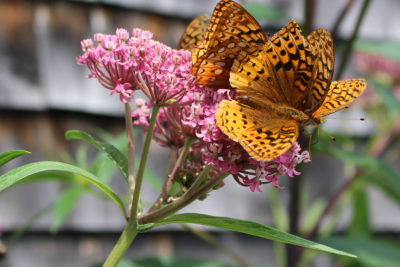
Swamp milkweed with fritillary
The warm, sunny days of midsummer are a great time to observe the many kinds of pollinators that visit flowers. In Maine, the pollinators include the ruby-throated hummingbird and a variety of insects, such as butterflies, moths, native bees (270+ species), honeybees, flies and beetles. Some of these pollinators are colorful and showy, while others are tiny and may require quiet observation before you see them. In natural areas, meadow, seaside, and wetland plants are most floriferous in the summer. Garden plants such as annual flowers, herbs, and vegetables, many of which are from tropical or Mediterranean climates, also bloom in the summer, when the temperature is most similar to their homeland. Spend some time really looking at a variety of flowers in the wild, in your garden, or in the shopping center parking lot, and notice if pollinators are visiting those plants.
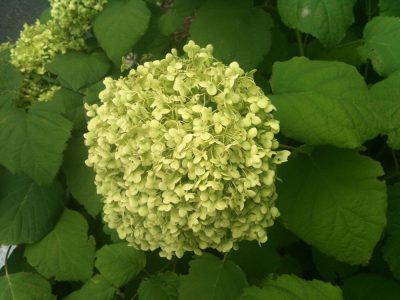
Hydrangea cultivar Annabelle
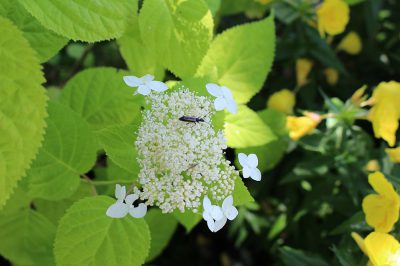
Wild form of the eastern native hydrangea (Hydrangea arborescens)
The sex life of plants
Because plants are not mobile, they are dependent on pollinators to aid in the transfer of pollen (plant sperm) from one plant to another to produce offspring that are genetically diverse individuals. Each of these individuals will vary in their ability to deal with conditions such as drought or extended rainy weather, excessive heat or cold, and even pollution. In the wild, a healthy plant population successfully pollinated will result in many diverse offspring, some of which will hopefully have traits that help them thrive in the given environment.
Flowers are a plant’s instrument of sexual reproduction, and their appearance is shaped by a plant’s relationship with its pollinators. The petals serve as a visual flag and landing pad. As the pollinator reaches the nectar source (the attractant), it bumps into the sex organs of the plant (stamens and pistils). Pollen sticks to its body, and the pollinator transfers the pollen to other flowers. Plants that are wind pollinated, such as grasses and many tree species, tend not to have colorful flowers. Instead, they produce a lot of pollen in the atmosphere (aggravating some people’s allergies) and rely on the wind to carry it to other plants.
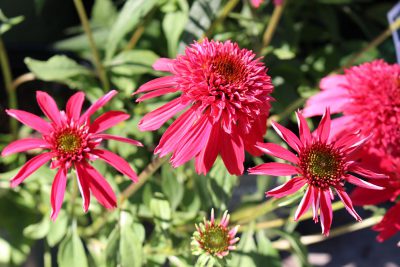
Double Echinacea
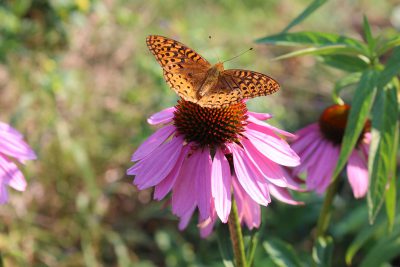
Wild form of Echinacea with Fritillary butterfly
Sexually dysfunctional plants
Not all flowering garden and landscape plants attract pollinators. There are a variety of reasons for this: If the plant is from another part of the world, it may have evolved to work with a pollinator that does not exist here, and its flower parts may be so specific to this pollinator that none of our native insects or hummingbirds fits with its design. Another reason garden plants may not attract pollinators is that they have been bred for traits that are attractive to gardeners but that inhibit the plant’s ability to sexually reproduce, such as double flowers.
In plants with double flowers, the stamens and pistils have mutated to look like petals. These flowers are sexually dysfunctional; without stamens, pistils, or nectar, the plants do not attract pollinators or produce seeds, the end result of sexual reproduction. Furthermore, the pollinators, birds, and other wildlife that depend on fruits or seeds receive no nourishment from these plants.
Plant reproduction without sex—cloning
Because these varieties do not produce seed, they are propagated through asexual reproduction. Until recently, this was done by dividing the root system or cutting the growing tips of stems, which will produce roots if maintained in a moist environment. Today, these plants are often cloned in a laboratory with a process called tissue culture. Cells from the desired plants are removed and grown in a petri dish until they divide and form new genetically identical plants. There is a trend today to give a trade name to these plants and even patent them so that their reproduction is controlled by the patent owner and individuals cannot propagate them.
Garden plants and food crops that do attract pollinators
Plenty of exotic garden plants do attract pollinators. Many herbs have flowers that have not been altered by domestication or breeding. Dill, parsley, cilantro, chives, marjoram, sage, and rosemary all have flowers that attract pollinating insects and are not invasive. There are also many annual and perennial flowers that attract pollinators to their nectar-filled blossoms such as lavender, nasturtium, calendula, marjoram, zinnia, catmint, breadseed poppy, cosmos, sunflower, coneflower, clover, borage, bee-balm, fuchsia, and many others. If you want to add these plants to your garden, look for single rather than double forms.
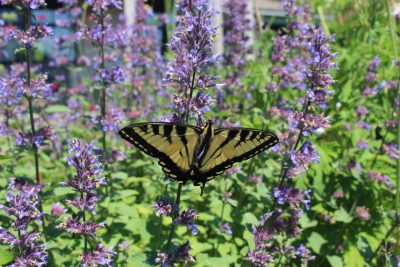
The native Tiger swallowtail (shown on garden catmint) needs native plants for its caterpillar stage, but can forage on the nectar of many garden plants.
Native plants for year-round pollinator support
While these garden plants are a great source of nectar for the butterflies, bees, and hummingbirds, the pollinators are still dependent on the foliage of native plants for the caterpillar or larval stage of their lifecycle, and on the leaf litter, stems, or bark for overwintering habitat. It is well-known, for example, that monarch butterflies depend on native milkweed for their reproduction and growing caterpillars.
This interdependency is not unique—all native plants have coevolved with pollinators. The tiger swallowtail butterfly, for example, needs native deciduous trees and shrubs such as birch, cherry, and spicebush to raise its young. Luna moths feed in the canopy of native trees during their caterpillar stage, but drop down to the leaf litter in the fall to overwinter. Rake those leaves away and the Luna moth is gone. Many native bees are solitary creatures and lay their eggs in the hollow stems of dead branches or dry flower stalks. A landscape that is overly tidy removes year-round habitat for these creatures. Because they support the whole life cycle of the pollinator, it is important to include native plants in all of our landscapes and to relax our landscape style to provide safe places for these important players in the ecosystem.
For a chart of over 150 native species of perennials and woody plants organized by bloom time, see our PDF on Native Pollinator Plants by Season of Bloom.
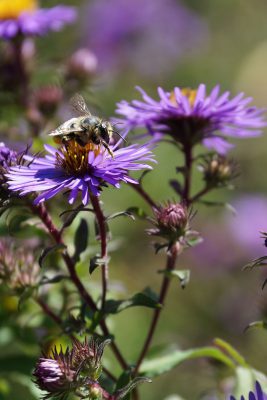
NE Aster with bee
Mowing and pollinators
If you can, delay your meadow mowing until late in the season (November). Your meadow will not return to forest in one season, and left un-mown, it will have butterflies, bees, lightening bugs, birds, reptiles, and all those creatures who live out their life (eat, procreate, raise their young) during our short New England growing season. You can mow paths through it for ease of walking. Many of the seeds of our native meadow wildflower ripen well into November and, if they are left standing, they have the best chance of dispersing and will feed birds and small animals over the winter. For perennial and shrub beds, leave dried stalks and seedpods standing and let the leaves rest where they fall to provide protection for the numerous creatures that make the leaf litter their home.
For more details on managing meadows, read Return of the Meadow and Managing Meadows and Lawns for Beauty and Biodiversity.
Native Gardening Blog
After removing disruptive introduced species, try planting these
Join Our Team!
Landscaping in partnership with native ecosystems is good for the planet. It’s good for us too.
Building Biodiverse & Climate-Resilient Habitats
Supporting Ash Protection Collaboration Across Wabanakik

